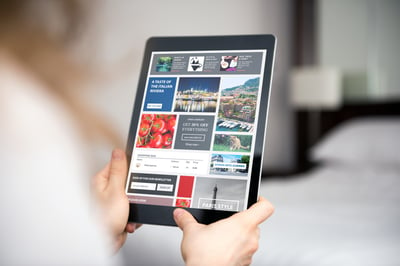November 22, 2024
 by Lou Burton / November 22, 2024
by Lou Burton / November 22, 2024

We go to great lengths to secure our software — from business-owned devices to carefully choosing CRMs for collecting and storing customer data. But did you know something as simple as a paper visitor book can undermine all those strategic choices?
When it comes to workplace safety and security, more is more. As we continue to rely on digital solutions to help secure the workplace, and as people take ownership of their data privacy rights, it’s essential to protect not only your employees but also your visitors and their data.
The paper check-in book, often left on the reception desk, leaves your organization vulnerable to data breaches, non-compliance with privacy laws, and the risk of physical damage. Let’s explore how upgrading your visitor security can better protect your workplace.
Visitor security keeps employees safe, identifies potential threats, and ensures visitors feel comfortable with how their data is collected, stored, and used. It plays an important role in your workplace visitor management strategy and helps your organization meet regulatory compliance.
Ensuring high levels of security requires strict control over access and monitoring visitor activity. Doing so helps mitigate risk, reduces the chance of a security breach, and creates a safe and welcoming atmosphere.
By adhering to regulatory requirements, your business can avoid legal pitfalls and demonstrate a commitment to the safety and well-being of everyone who steps through its doors. A well-rounded approach to visitor security is vital for maintaining the safety, security, and reputation of any organization.
Prioritizing visitor security is not just a best practice — it’s a legal requirement. Mishandling personal data can put your business at huge risk, both financially and in terms of reputation and trust.
Laws like the GDPR (UK and Europe), CCPA (California), C-TPAT (Canada), and the privacy act (Australia) have changed how businesses handle personal data. For organizations operating in any area where a data privacy law exists, compliance is extremely important to avoid financial penalties and bad press as facebook experienced in 2023.
A compliant visitor management system (VMS) goes beyond simply recording who enters and exits your facility. It makes sure that visitor information is securely stored, accessible only by authorized personnel, and handled to respect individual privacy.
Paper visitor books, on the other hand, pose multiple risks. They are easily accessible to anyone and can be tampered with, leading to a violation of regulatory compliance. What’s more, it’s nearly impossible to find and delete data. For example, if a visitor requests their data be deleted, finding and removing it from a paper book without compromising other sensitive information might be difficult and time-consuming.
In this regard, a visitor management system not only helps maintain compliance but also shows a commitment to protecting the privacy and security of visitors. By implementing modern and compliant solutions for visitor security, you’ll safeguard business operations, build trust with stakeholders, and avoid severe penalties associated with data breaches.
A GDPR-compliant visitor book is a digital system designed to securely log and manage visitor information in line with the privacy laws set by the General Data Protection Regulation (GDPR). Typically hosted on a tablet, it ensures that personal data is encrypted and securely stored in the cloud.
Access to the information is restricted to authorized personnel, and all data can be anonymized at the touch of a button, thanks to secure deletion protocols. This approach protects visitor privacy and helps you avoid hefty fines and legal issues associated with non-compliance.
An effective visitor security plan doesn’t just protect your physical spaces; it protects company data and resources. To minimize the risk of sensitive information being exposed, you’ll need a comprehensive security framework. This includes:
When it comes to keeping data secure, a paper visitor book is not compliant because anyone can walk in off the street and see personal data such as full name, email address, and phone number of past visitors.
As people become more aware of their data privacy rights, their expectations have shifted. They need to know that their personal data is secure. That means your organization needs to monitor who’s on-site and when they arrive to handle data according to data privacy laws.
Implementing a VMS optimizes your organization’s visitor check-in process, enhances security, and protects against unauthorized access. On top of that, it helps your organization remain compliant with regulatory requirements in your region.
Here’s how its features can enhance security and manage access effectively:
These features will set your organization up with an effective security procedure while maintaining a smooth and professional visitor experience.
The liability for ensuring security and compliance rests squarely with the business, not the visitor. Organizations using a visitor management system must maximize their benefits by focusing on both security and regulatory compliance in equal measure.
A good visitor management system should always be ready for compliance audits and give you the ability to anonymize data upon request or within the timeframe outlined by the local regulations.
It’s not a matter of if your business will be audited, but when. A VMS helps you stay audit-ready when that time comes, even on short notice.
This is especially meaningful for GDPR compliance, where minor lapses can lead to hefty fines and damage your organization’s reputation. A visitor management system enables you can be audit-ready at the touch of a button, helping to maintain compliance, protect your organization from legal repercussions, and communicate your commitment to data protection legislation.
To meet regulatory compliance with data retention policies, visitor management systems often include an auto-anonymization feature. This feature automatically anonymizes personal information after a specified period to significantly reduce the risk of data breaches. Or you can anonymize visitor data immediately at the individual’s request.
The option to anonymize data means you can limit exposure to sensitive information and, in turn, liability for data breaches. Any organization operating under the GDPR, ITAR, CCPA, C-TPAT, or the Privacy Act can benefit from this feature.
Encryption is the cornerstone of visitor management systems. When choosing a visitor management system, you'll need to make sure that the provider is both ISO and SOC-2 accredited-certifications that confirm the use of industry-standard encryption to keep your data safe.
It’s more important than ever that employees recognize the importance of checking in their visitors securely and according to company policy. This simple action plays an essential role in maintaining a secure and compliant workplace. Proper employee training ensures your team understands the significance of maintaining security and compliance when welcoming visitors.
Consider providing regular refresher courses on data protection laws and internal security protocols. This way, you can help employees stay informed about the latest best practices, potential risks, and real-world cases of compliance breaches. Give employees the knowledge and autonomy to confidently handle visitor interactions while remaining secure and compliant.
Rather than managing risks as they come up, focus on mitigating them before they happen.
Start by developing a visitor security policy outlining clear procedures for handling visitor access and data. The result? Reduce the likelihood of security breaches and protect sensitive information.
By taking this proactive approach, you have the opportunity to create a culture of security awareness and empower every employee to play a role in maintaining a secure working environment.
Bring out the best in your team. Discover software that boosts office efficiency and creates an organized workspace!
Edited by Monishka Agrawal
Lou Burton is Brand & Content Manager at SwipedOn, an ultra-flexible sign-in software that aims to digitize and secure every kind of workplace sign-in.
Until we gain supernatural powers to reveal human identities, we run the risk of allowing...
.png) by Shreya Mattoo
by Shreya Mattoo
Remarketing is the reason you end up seeing so many relevant ads on random pages after paying...
 by Ricky Wang
by Ricky Wang
In this digital day and age, any and every experience can be turned into combinations of 1s...
 by Chanakya Kyatham
by Chanakya Kyatham
Until we gain supernatural powers to reveal human identities, we run the risk of allowing...
.png) by Shreya Mattoo
by Shreya Mattoo
Remarketing is the reason you end up seeing so many relevant ads on random pages after paying...
 by Ricky Wang
by Ricky Wang


